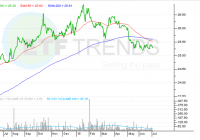CIBR Gives Investors Another Chance To Profit From Hot Growth Market
First Trust brings a new cybersecurity ETF to market to serve underserved sector. The First Trust Nasdaq CEA Cybersecurity ETF has a cheaper expense ratio and more frequent re-balancing, providing key differences to the PureFunds ISE Cyber Security ETF. The PureFunds Cybersecurity ETF is up more than 15% in 2015 and has shown the strength and growth of the sector. First Trust, a top ten fund management company, recently introduced the First Trust Nasdaq CEA Cybersecurity ETF (NASDAQ: CIBR ) to the public. The ETF gives investors a new way to invest in a basket of stocks in the hot growth cybersecurity market. After watching the strong growth of the PureFunds ISE Cybersecurity ETF (NYSEARCA: HACK ), which I profiled in December, investors will want to take a look at this new name. The new First Trust ETF will invest in stocks deemed to fit into the cybersecurity class by the Consumer Electronics Association. Other rules for inclusion are a minimum market capitalization of $250 million, average volume of $1 million over last 3 months, and a minimum free float of 20%. The First Trust fund holds 33 stocks. The companies selected range in market capitalization from $322 million to $139 billion. The average capitalization is $6.8 billion. Here is the current (7/7) top ten holdings for the First Trust ETF: Company Symbol Market Capitalization Weighting Qihoo 360 Tech QIHU $6.9 billion 6.8% FireEye FEYE $7.4 billion 6.2% Palo Alto Networks PANW $14.4 billion 6.1% Cisco Systems CSCO $137.3 billion 5.7% NXP Semiconductors NXPI $21.5 billion 5.2% Imperva IMPV $2.0 billion 3.2% Proofpoint PFPT $2.5 billion 3.2% Vasco Data VDSI $1.1 billion 3.1% Fortinet FTNT $6.9 billion 3.1% Splunk SPLK $8.5 billion 3.1% As of July 7th , there was an overlap of six companies between the two ETF’s top ten holdings. The stocks held by both in the top ten are (weighting in HACK): Proofpoint: 4.3% Imperva: 4.3% Fortinet: 4.2% Splunk: 4.2% Palo Alto Networks: 4.1% Cisco: 4.0% Along with the difference in the top ten holdings, a couple other differences are worth pointing out. The first and obvious one is expense ratio. PureFunds charges 0.75% on the ETF and First Trust will be charging 0.6%. While this isn’t a huge difference, it does mean you will pay more for PureFunds to manage your investment. The other big difference is re-balancing. PureFunds re-balances their holdings on a semi-annual basis. First Trust is planning on quarterly re-balancing. I have to side with First Trust on this one as it is the more active management and allows the company to make necessary changes more often. Since going public, shares of the PureFunds ETF have traded between $24.44 and $33.91. As of Wednesday, they were trading for $30.48 per share. The ETF is up 15.1% in 2015 to date. Shares have increased 17.9% over the last six months. Since my December article recommending the ETF, shares are up more than 11%. The ETF has also seen a large number of inflows since the start of 2015 as the sector heats up and the fact that investors had only one option. The ETF passed the $1 billion mark and as of June had more than $1.2 billion assets under management. Cybersecurity continues to be a hot growth market. Anytime there is a major security breach, the whole sector rises. Companies and major agencies continue to spend large amounts of money to protect themselves from future attacks. According to the First Trust prospectus , cybersecurity is expected to see compound annual growth of 10.3% to hit $155.7 billion by the year 2019. I pointed out the opportunity in cybersecurity back in December. At that time the hacks on Sony (NYSE: SNE ), Target (NYSE: TGT ), and Home Depot (NYSE: HD ), were still fresh in people’s minds. In June, the whole sector rose on the heels of a major government hack. The companies in this category get money when things go bad or for cleaning up messes, but ultimately get the majority of their revenue from prevention. The White House is also proposing to spend more than $14 billion in fiscal 2016 to help support cybersecurity measures. The market for cybersecurity is heating up and likely will see the projected double digit annual growth. Investors have the option to hand pick one or two stocks in the sector or buy one of these two ETFs to get invested in the sector. As far as a recommendation, I think both ETFs will outperform the market as this sector should stay hot for at least the next five year cycle. I think it would be wise to consider the new First Trust ETF with the lower expense ratio, and more frequent re-balancing. It’ll be interesting to see if First Trust gets new investor money or the assets under management on HACK takes a small hit from investors looking for greater newer investment options. Disclosure: I/we have no positions in any stocks mentioned, but may initiate a long position in CIBR over the next 72 hours. (More…) I wrote this article myself, and it expresses my own opinions. I am not receiving compensation for it (other than from Seeking Alpha). I have no business relationship with any company whose stock is mentioned in this article.
